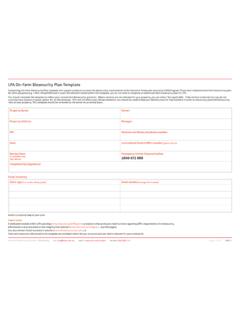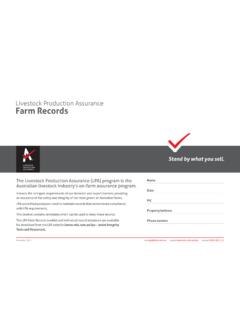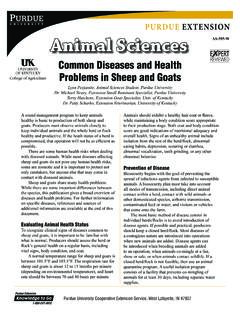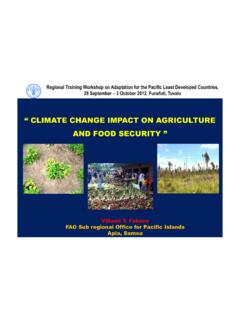Transcription of Dairy Standards
1 October 2017. Dairy Standards 1st October 2017 (updated 1st June 2018). Version Welcome Welcome to the Red Tractor Assurance for Farms Dairy Scheme Standards , part of the Red Tractor Food Assurance Scheme assuring food safety, animal welfare, hygiene and environmental protection through every part of the food chain. These Standards have been written and revised by our Technical Advisory Committees (TACs) in consultation with customers, farmer representatives and the wider industry to ensure they are clear and provide meaningful, credible farm assurance for all. This is essential with the increasing demand for traceability offood, growing consumer awareness of animal welfare issues in livestock production and a need to minimise pesticide residues. For more information about the Red Tractor Assurance Scheme visit Guide Scheme members are advised this manual must be read in conjunction with the How the Red Tractor Assurance Scheme Works'.
2 Leaflet which details the Rules of the Scheme that all members are bound by. This manual also includes the Red Tractor Assurance for Farms - Beef and Lamb Standards . In the devolved regions, the regional standard applies and supersedes any Beef and Lamb only Standards included in this manual. Dairy farmers in England must meet the beef specific Standards in order for any cull cows, calves or other cattle to be marketed as assured. The sheep requirements only apply to farmers certified for sheep. The Standards are organised in sections. The AIM of each standard or group of Standards is clearly explained. All of the words against each standard including the column How you will be measured' form part of the standard. Standard coding begins with a two letter prefix that identifies the section. Assessors will use this code together with a code to identify the enterprise to which it relates ( DR for Dairy ) to identify any non-conformances on the report at the end of the assessment.
3 Key those Standards which have greater significance (all other Standards are normal). Recommendation those which do not affect certification New a completely new standard which the member must now adhere to Revised a standard that has changed and requires the member to take some different or additional action to before Upgraded the standard has been upgraded to a Key standard or from a Recommendation to a full standard Appendix t his is referenced in the How you will be measured' column and indicates that additional information is provided in the Appendices at the back of this manual R - this icon indicates that a record is required here to find help - at the end of each section we have indicated where you can get extra guidance if you need it. W. (Our interactive pdf version of this document available on will automatically take you to the right documents and sources of more help). 1 Red Tractor Assurance for Farms Dairy Standards Assured Food Standards 2018.
4 Contents Content DP DOCUMENTS AND PROCEDURES 03. SC STAFF AND LABOUR PROVIDERS 03. TI TRACEABILITY AND ASSURANCE STATUS 05. VC VERMIN CONTROL 06. MP Milk Production 07. HF HOUSING, SHELTER AND HANDLING FACILITIES 11. FW FEED AND WATER 13. AH ANIMAL HEALTH AND WELFARE 16. CR ARTIFICIALLY REARED YOUNGSTOCK (CALVES AND LAMBS) 18. BI BIOSECURITY AND DISEASE CONTROL 19. AM ANIMAL MEDICINES AND HUSBANDRY PROCEDURES 19. FS FALLEN STOCK 21. LT livestock TRANSPORT 22. AG RESPONSIBLE USE OF AGROCHEMICALS 23. NM NUTRIENT MANAGEMENT 25. Appendices 26. Member Rules 44. NOTES 48. Certification bodies 51. What has changed since October 2017. Date of change Standard Page 01 June 2018 19. Red Tractor Assurance for Farms Dairy Standards Assured Food Standards 2018 2. DOCUMENTS AND PROCEDURES (DP). Standards HOW YOU WILL BE MEASURED. AIM: Plans and procedures in place to ensure safe and legal food production n . Accumulated rubbish, redundant equipment or scrap kept in controlled areas Systems must be in place to maintain the separate from livestock / feed storage areas/ public areas farm in a manner that does not present risks to food safety, animal welfare and environmental protection n.
5 farm map shows where applicable: A farm map must be in place (New) R. all buildings all fields, including area (hectares/acres) n farm map watercourses including ditches and ponds boreholes, springs and wells, including any on neighbouring land, within 50m of the boundary any areas of high pollution risk bait point locations n . You have considered the risks to your farm and documented A documented plan for the effective the actions to be taken in the event of, for example: R. management of serious incidents and feed and/or water equipment failing n Emergency potential emergency situations that plan power cuts, milking equipment failure threaten the welfare of livestock , food safety or the environment must be in place extreme weather (drought, flooding, snow). and known to key staff disease outbreaks which have the potential to affect other farms/ the general public reporting activist activity (to police, relevant trade body, your Certification Body, milk buyer).
6 Pollution incident n . Plan includes relevant contact details (including out of hours phone numbers) vet, electricity supplier, milk buyer, haulier, Environment Agency hotline, feed and water suppliers n . Key staff have access to plan n . Complaints made by Local Authority, general public, Systems must be in place for recording, customers ( abattoir feedback) or other R. investigating and resolution of any n . Complaints including, but not limited to, antibiotic failures, n Complaints complaints received that are relevant to the welfare and environmental issues Record requirements of the Dairy Standards n . System includes recording the: complaint investigation result action taken to prevent the issue happening again n . Prescribing vet involved in investigation, reviews medicine Where two or more antibiotic failures are use and makes recommendations to prevent the issue R. reported in a rolling 12 month period the happening again n Vetreview prescribing vet must be notified (New) n.
7 Vet review recorded in the complaints record recorded in complaints record 3 Red Tractor Assurance for Farms Dairy Standards Assured Food Standards 2018. Standards HOW YOU WILL BE MEASURED. n . New production sites include, but are not limited to new and existing parlours, Producers must ensure that new buildings, grazing land, including that used seasonally production sites are suitable for use n . The Certification Body has been informed of the site and where applicable have added them to your Red Tractor membership n . When deciding if suitable for use, consideration has been given to the following where relevant: previous use recent applications of chemicals and soil improvers (including sewage sludge and chicken manure). physical hazards injurious weeds possible disease or parasitic risks from previous or nearby stock downstream watercourses Where to n For information on farm fires see the Defra guidance document farm Fires Protecting farm Animal Welfare'.
8 Find help n For additional guidance on animal welfare in severe weather visit n For additional practical guidance on dealing with livestock in droughts and flooding visit n To find out the environmental state of water bodies around and through your land use the Environment Agency's What's in your Backyard Tool STAFF AND LABOUR PROVIDERS (SC). Standards HOW YOU WILL BE MEASURED. AIM: All staff (including, but not limited to, full and part-time and family members and relief milkers) are trained and competent to carry out the activities they do Key n . Nobody starts work without an induction, supervision or explanation of the Systems must be in place to ensure that all tasks they will carry out new staff are effectively trained and deemed n . For any specific tasks referenced within the Standards ( medicine competent to carry out the activities they treatments) additional training is given prior to being left to complete the task are employed to do unsupervised, if it has not already been given n.
9 If you have any staff they are regularly observed and the output of their work The performance and competence of staff reviewed must be regularly reviewed and refresher n . Refresher training is implemented immediately if issues are found training implemented as required Recommendation n . Annual, documented assessment of skills and competency It is recommended that a formal, documented R. annual review is undertaken n Annual review form n . A training record is available for all, including: Records of training must be kept R. name start date (if applicable) n Staff training training given/ events attended/ experience record date of training who provided the training n . Where staff are trained to undertake specific tasks this is listed in the record n . Records kept for two years after staff member has left employment Recommendation n . Active membership to schemes including Dairy Pro, IntSCA or equivalent It is recommended that at least one staff member per site is a member of a scheme that records skills/ development/ training Red Tractor Assurance for Farms Dairy Standards Assured Food Standards 2018 4.
10 Standards HOW YOU WILL BE MEASURED. n . Agreement in place where labour providers are used Where labour providers are used to supply regularly or on an ad-hoc basis R. temporary or permanent staff an agreement n . Agreement confirms that labour provided is competent and n Labour must be in place to ensure competent that a Gangmasters Licence is held provider persons are provided agreement Where to n For guidance on Dairy Pro visit find help n For further information on Gangmasters Licensing and to check the licence status of a labour provider visit TRACEABILITY AND ASSURANCE STATUS (TI). Standards HOW YOU WILL BE MEASURED. AIM: Clear identification of livestock to deliver food chain traceability Key n . Cattle are double tagged within 20 days of birth (first tag Cattle must be identified and records kept within 36 hours of birth if Dairy bred) and have a UK passport R. to maintain traceability n . Births, deaths and movements are recorded in up-to-date n Herd herd records and notified to the national database within the records required timeframe ( BCMS within 27 days of birth, n Movement seven days of death and three days of movement).










